|
The Film

 Microwave Massacre (Wayne Berwick, 1983) Microwave Massacre (Wayne Berwick, 1983)
Construction worker Donald (Jackie Vernon) and his wife May (Claire Ginsberg) live an unhappily married life: all Donald wishes is to eat simply, craving a bologna sandwich in his packed lunch, but May insists on concocting increasingly strange and pretentious dishes, sending her husband to work with an undressed crab in his lunch box. In an attempt to improve her ‘cue-sine’, May takes receipt of a huge 1970s era microwave oven. Driven to despair by May’s nagging, one day Donald snaps and bludgeons his wife to death. Following his murder of May, Donald carves up her corpse, inexplicably cooking it in the microwave before storing it in the freezer in his garage.
When, one day, Donald accidentally eats part of May’s corpse, mistaking it for meat, he finds a new appetite for human flesh. The incident propels him onto a path of cannibalism. Subsequently, Donald finds himself picking up a strong of beautiful young women, who inexplicably throw themselves at the aging, portly construction worker. Following coitus, Donald feels compelled to murder and consume these women, cooking them in the huge microwave oven and storing their flesh in his increasingly tightly-packed freezer. He also shares some of this meat with his colleagues on the construction site, who – unaware that they are eating human flesh – praise Donald’s culinary skills. However, when May’s sister Evelyn (Sarah Alt) turns up on Donald’s doorstep, things become increasingly complicated.
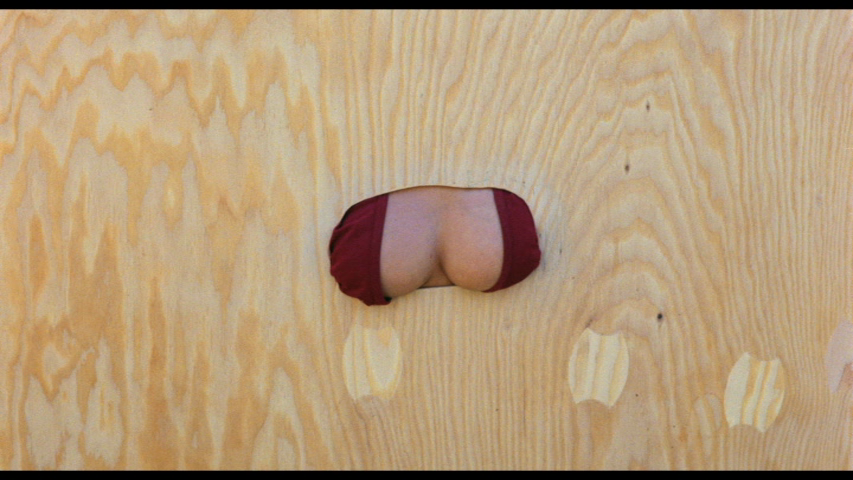 Throughout, the film relies on black humour which is often scattershot and could best be described as hit and miss. However, when the picture hits the mark, often owing to Jackie Vernon’s deadpan delivery of his lines, it can be very funny – such as when Donald finally snaps and murders May by bludgeoning her to death with the salt shaker, stopping part-way through the act to superstitiously throw salt over his left shoulder. Elsewhere, the humour is often smutty. Throughout, the film relies on black humour which is often scattershot and could best be described as hit and miss. However, when the picture hits the mark, often owing to Jackie Vernon’s deadpan delivery of his lines, it can be very funny – such as when Donald finally snaps and murders May by bludgeoning her to death with the salt shaker, stopping part-way through the act to superstitiously throw salt over his left shoulder. Elsewhere, the humour is often smutty.
The film features some abrupt and bizarre shifts in tone that are signaled from its opening moments. The opening shot of the picture is a slow zoom in to the microwave, which contains May’s dessicated severed head. This is then followed immediately by the film’s opening titles, which play out over a shot of the large breasts of the construction workers’ ‘groupie’ (Marla Simon). This young woman peers at the workers through a large hole in one of the walls bordering the construction site. As she is bent over, gazing through the hole, a man sneaks up behind her and ‘gooses’ her. Her breasts press against the knothole, spilling out of her top. One of Donald’s colleagues declares, in response to this, ‘I have to go to the breast room… I mean, rest room’. It’s the kind of crude, bawdy humour that belongs in the seaside postcards of Donald McGill, The Benny Hill Show (1969-89) or any of the Carry On… films. Later, the same young woman wanders onto the construction site and teases the workers there, picking out one of them for a sexual encounter. She asks one of Donald’s colleagues what they are building. ‘A skyscraper’, she is told, ‘Want to see it rise?’ Making conversation, she tells the construction worker that ‘men are usually after one thing’. ‘Yeah?’, he asks, looking at her large breasts, ‘How do they choose?’
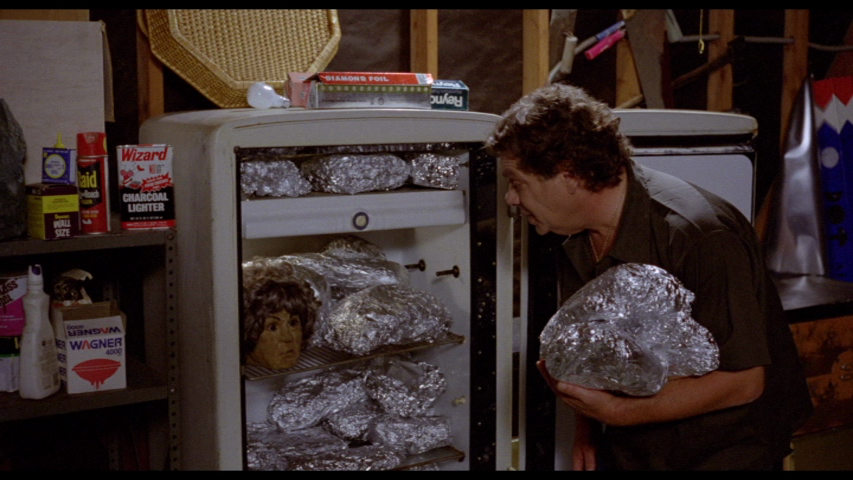 May insists on cooking her construction worker husband Donald, who only lusts after a bologna sandwich, increasingly bizarre meals. In aid of this, she purchases the microwave oven alluded to in the title – but which has a very minor role to play in the narrative itself. (The modern viewer might have to remember that during the 1970s, microwave food – like the ownership of a freezer – was seen as sophisticated.) In this, the film not-so-subtly pokes fun at middle class aspirations of betterment, with May’s accent undermining her attempts at linguistic sophistication – so ‘cuisine’ becomes pronounced as ‘cue-sine’, and at one point May tells her husband that his dinner is an example of ‘cordon blue’. However, Donald wants nothing more than simple food: ‘Why can’t you fix something simple anymore?’, he begs May, ‘I woke up in the middle of the night dreaming about food I can eat with my hands’. ‘You don’t know anything about being a conny-sewer’, May responds, her accent mangling the word connoisseur, ‘You don’t know how to enjoy life’. May insists on cooking her construction worker husband Donald, who only lusts after a bologna sandwich, increasingly bizarre meals. In aid of this, she purchases the microwave oven alluded to in the title – but which has a very minor role to play in the narrative itself. (The modern viewer might have to remember that during the 1970s, microwave food – like the ownership of a freezer – was seen as sophisticated.) In this, the film not-so-subtly pokes fun at middle class aspirations of betterment, with May’s accent undermining her attempts at linguistic sophistication – so ‘cuisine’ becomes pronounced as ‘cue-sine’, and at one point May tells her husband that his dinner is an example of ‘cordon blue’. However, Donald wants nothing more than simple food: ‘Why can’t you fix something simple anymore?’, he begs May, ‘I woke up in the middle of the night dreaming about food I can eat with my hands’. ‘You don’t know anything about being a conny-sewer’, May responds, her accent mangling the word connoisseur, ‘You don’t know how to enjoy life’.
The henpecked Donald is played sympathetically by Jackie Vernon, in a role apparently originally intended for Rodney Dangerfield (and it’s easy to imagine Dangerfield as Donald) – so much so that the viewers may find its casual treatment of his female victims distasteful; in some ways, the film feels like a bizarre parody of later serial killer pictures such as John McNaughton’s Henry: Portrait of a Serial Killer (1986). However, its rich vein of dark humour connects it with Jeff Gillen and Alan Ormsby’s earlier blackly comic picture about Ed Gein, Deranged: Confessions of a Necrophile (1974). Meanwhile, the cutaways to Donald’s saucy neighbour, who displays a seemingly insatiable appetite for anonymous sex (and in one scene is shown gardening whilst holding an operative vibrator), seem inserted from one of Russ Meyer’s 1970s pictures (such as Supervixens, 1975).
 Prior to Donald’s murder of May, he experiences several flights of fantasy in which he rebels against his wife – by, for example, emptying the contents of her vacuum cleaner over the living room furniture and pissing in the hearth. These moments are presented for the audience ‘straight’, as if they are part of the main diegesis, and it’s only once they’re over that we realise they were fantasy sequences. This blurring of fantasy and reality in a suburban setting might cause viewers to recall Thomas Berger’s roughly contemporaneous satirical novel Neighbors (1980, adapted for the screen by John G Avildsen, with John Belushi and Dan Aykroyd, in 1981), in which the protagonist, Earl Keese, experiences a nightmarish and paranoid fusion of fantasy and reality owing to his suburban alienation; like Neighbors, though less successfully, Microwave Massacre presents the everyday as full of almost Kafkaesque potential. Consequently, when Donald finally snaps and kills his wife, it’s tempting to read this as yet another of Donald’s daydreams, and Donald himself seems to perceive it this way too – until he wakes up the next morning and finds May’s corpse on the kitchen floor. Following this, there’s an escalating sense of the absurd to Donald’s subsequent ability to pick up beautiful young women and persuade them to come home with him for sex – almost as if much of the film takes place inside Donald’s private fantasy world. These encounters become increasingly unlikely: Donald begins with a prostitute he meets in his local bar (named Dee Dee Dee – ‘Have you ever screwed in 3D?’), then a young French woman dressed as a chicken (‘You’re too good a chick to be dressed as a chick’), and a hitchhiker, and so on. Prior to Donald’s murder of May, he experiences several flights of fantasy in which he rebels against his wife – by, for example, emptying the contents of her vacuum cleaner over the living room furniture and pissing in the hearth. These moments are presented for the audience ‘straight’, as if they are part of the main diegesis, and it’s only once they’re over that we realise they were fantasy sequences. This blurring of fantasy and reality in a suburban setting might cause viewers to recall Thomas Berger’s roughly contemporaneous satirical novel Neighbors (1980, adapted for the screen by John G Avildsen, with John Belushi and Dan Aykroyd, in 1981), in which the protagonist, Earl Keese, experiences a nightmarish and paranoid fusion of fantasy and reality owing to his suburban alienation; like Neighbors, though less successfully, Microwave Massacre presents the everyday as full of almost Kafkaesque potential. Consequently, when Donald finally snaps and kills his wife, it’s tempting to read this as yet another of Donald’s daydreams, and Donald himself seems to perceive it this way too – until he wakes up the next morning and finds May’s corpse on the kitchen floor. Following this, there’s an escalating sense of the absurd to Donald’s subsequent ability to pick up beautiful young women and persuade them to come home with him for sex – almost as if much of the film takes place inside Donald’s private fantasy world. These encounters become increasingly unlikely: Donald begins with a prostitute he meets in his local bar (named Dee Dee Dee – ‘Have you ever screwed in 3D?’), then a young French woman dressed as a chicken (‘You’re too good a chick to be dressed as a chick’), and a hitchhiker, and so on.
 At its heart, the film revolves around the twin appetites for food and sex and how both of these can be frustrated. Donald’s first murder is of course directed against his harridan of a wife, with whom Donald hasn’t had sex in almost twenty years. (At one point, May calls Donald ‘a walking contraceptive’, telling him ‘I can’t remember the last time you were romantic with me’; in response, Donald goes into stark detail: ‘I remember. It was April, 1962. It was a Thursday afternoon. It was raining out’.) May has both denied Donald his appetite for sex and has failed to provide him with the food he desires to appease his hunger, instead presenting him with increasingly complicated and, to Donald, unappetising meals. Donald has, in a sense, become a slave to May’s aspirational character, represented through her adoption of the microwave oven and her insistence on preparing meals which are intended more as status symbols than as meals for Donald to eat and enjoy. Just prior to his murder of May, Donald complains that his meal – prepared using May’s beloved microwave oven – ‘looks like something someone ate three days ago’. ‘It’s a delicacy and it’s cheap’, May tells him firmly, ‘and it really helps my food money go far’. At its heart, the film revolves around the twin appetites for food and sex and how both of these can be frustrated. Donald’s first murder is of course directed against his harridan of a wife, with whom Donald hasn’t had sex in almost twenty years. (At one point, May calls Donald ‘a walking contraceptive’, telling him ‘I can’t remember the last time you were romantic with me’; in response, Donald goes into stark detail: ‘I remember. It was April, 1962. It was a Thursday afternoon. It was raining out’.) May has both denied Donald his appetite for sex and has failed to provide him with the food he desires to appease his hunger, instead presenting him with increasingly complicated and, to Donald, unappetising meals. Donald has, in a sense, become a slave to May’s aspirational character, represented through her adoption of the microwave oven and her insistence on preparing meals which are intended more as status symbols than as meals for Donald to eat and enjoy. Just prior to his murder of May, Donald complains that his meal – prepared using May’s beloved microwave oven – ‘looks like something someone ate three days ago’. ‘It’s a delicacy and it’s cheap’, May tells him firmly, ‘and it really helps my food money go far’.
Donald’s murder of May results in his first act of cannibalism, when he accidentally consumes part of May’s flesh after mistaking it for a tasty morsel in his freezer (‘Looks like I may have underestimated May’s taste’, he says). From here, Donald connects his desires for sex and food via the acts of murder and cannibalism, picking up beautiful women and returning with them to his home, where he fucks them, kills them, cooks them and eats them. This connection is perhaps best represented via a non-diegetic insert which appears a couple of times in the film, in which a naked woman is shown laying on a table whilst a man’s hands (presumably intended to be Donald’s, even though the hands don’t appear to be those of Jackie Vernon) using a machete as a giant spatula to spread mayonnaise over her body before placing a huge slice of bread over her and cutting across her abdomen. Donald visits a doctor hoping for help with his ‘problem’, but finds the doctor is uninterested in his plight and falls asleep as Donald tells his story. However, in a scene shortly after this Donald seems to offer an astute self-diagnosis: noticing that the freezer in the garage is overflowing with the body parts of his victims, Donald observes, ‘I’m going to have to eat more or screw less. This is getting weird’.
Video
NB. For this review, we only had access to the DVD that is packaged with the Blu-ray release and so can’t offer as detailed comments on the presentation as we usually like to.
The film is uncut and, on the DVD at least, runs for 76:20 mins (PAL). Presented in the 1.85:1 aspect ratio (with anamorphic enhancement on the DVD presentation), the image is a detailed as one could hope for and free from damage. Contrast is fairly nicely balanced, and colour reproduction is good.
 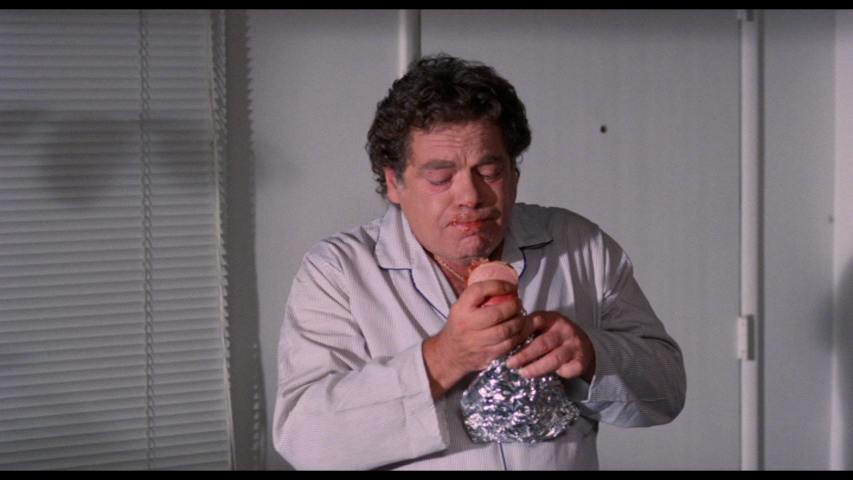 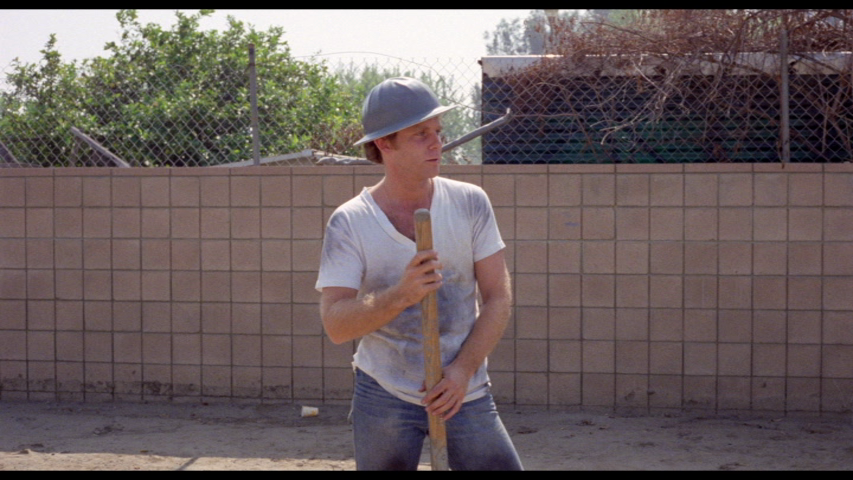
Audio
Audio, on the DVD presentation, is via a Dolby Digital 1.0 mono track which is clean and clear, with dialogue audible throughout. Some hiss and crackling is present here and there, but it shouldn’t disrupt one’s enjoyment of the film. Optional English subtitles for the Hard of Hearing are available, and these are easy to read and free from errors.
Extras
The DVD includes:
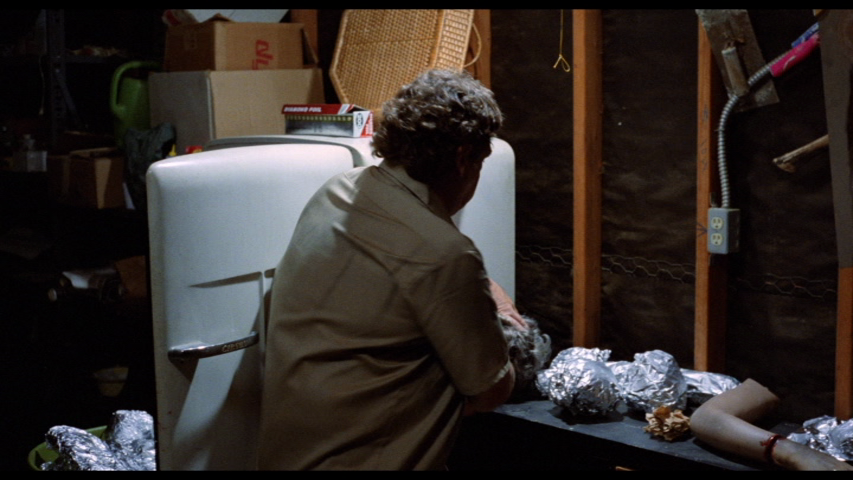 - Audio commentary with Craig Muckler. Moderated by Mike Tristano, this commentary track features Muckler offering some candid reflections on the making of the picture. It’s an entertaining track, filled with amusing anecdotes. - Audio commentary with Craig Muckler. Moderated by Mike Tristano, this commentary track features Muckler offering some candid reflections on the making of the picture. It’s an entertaining track, filled with amusing anecdotes.
- ‘My Microwave Massacre Memoirs’ (21:06). This featurette includes interviews with director Wayne Berwick, writer and producer Craig Muckler and actor Loren Schein. Berwick talks about the work of his father Irvin Berwick, who worked as a dialogue coach and director from the 1940s onwards. All three discuss Malibu High (Irvin Berwick, 1979), on which they collaborated with Wayne Berwick’s father. Muckler came up with ‘this incredible title, “Microwave Massacre”’ (in the words of Berwick). Muckler’s original synopsis was ‘completely different’ to the finished picture. Berwick informs the viewer that the film originally opened with May buying meat, but at the last minute ‘the grocery store pulled out’ and a new opening sequence had to be put together – resulting in the bawdy sequence featuring the construction workers’ ‘groupie’. The trio reflect on putting together a film with such a small budget, and Berwick reveals the interiors were shot at Mickey Dolenz’s house; at the table reading, ‘there was still no script’ and the writer Thomas Singer ran into the room with the script, fresh from the printers, ‘and it was all shtick’. Berwick admits that whilst some of this was funny, much of it wasn’t – and the whole thing was ‘like a Jackie Vernon standup routine but it had to go on for ninety minutes’. The ‘battle cry’ became ‘embrac[ing] the stupidity’ within the hastily cobbled-together script.
- Image Gallery (19 images).
- Trailer (1:24).
Retail copies also include reversible sleeve artwork and a booklet with new writing about the film by Stephen Thrower.
Overall
The huge microwave oven, probably unrecognisable as a home appliance to many younger viewers, somehow makes the film seem more dated than the fashions, haircuts or deliriously un-PC dialogue that, depending on the viewer’s personal tolerances may push the film into sheer tastelessness. (Reading news reports of one of Donald’s victims, a young African-American woman who has disappeared, one of the construction workers declares, ‘Now that’s my kind of dude: an equal opportunity rapist’.) Feeling very much like a Herschell Gordon Lewis picture, Microwave Massacre’s camp delights and focus on the murderous implications of domestic appliances make it a good companion piece to Terry Lofton and Bill Leslie’s equally no-budget The Nail Gun Massacre (1985). (There’s also a strange synchronicity with Lamberto Bava’s Macabre, 1980, which also features as a pivotal image a severed head in a fridge.) The humour is often blacker than black (‘I could eat a whore’, Donald asserts after murdering Dee Dee Dee) but, also equally often, Donald McGill-esque – like a saucy seaside postcard with a murderous subtext. (In an alternate universe, the film could be titled ‘Carry on Cannibalising Beautiful Young Women’.) Apparently written ‘off the cuff’, there’s an element of satire within the picture, and the whole film builds to a strangely ironic conclusion. It’s a slight film that is entertaining and challenging in equal measures, but is difficult to recommend as a ‘blind buy’ owing to the cheapjack production values which are reflected in the rudimentary photography and sound design. Nevertheless, those with a taste for the films of Herschell Gordon Lewis or the likes of The Nail Gun Massacre will certainly find the film enjoyable. Certainly, the presentation of the film on this DVD from Arrow Video is very good, and is accompanied by some excellent contextual material.
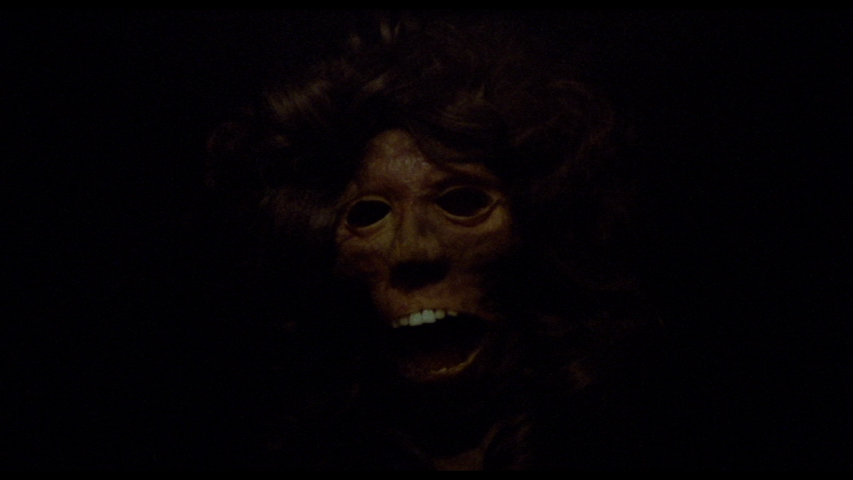
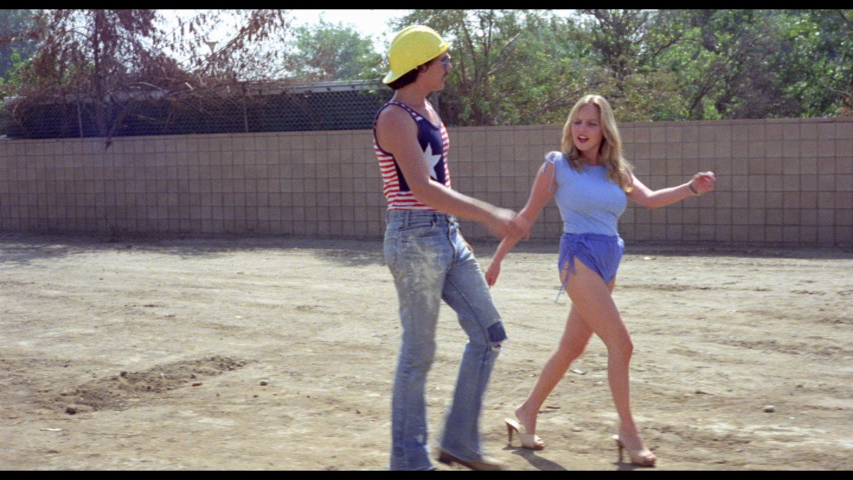
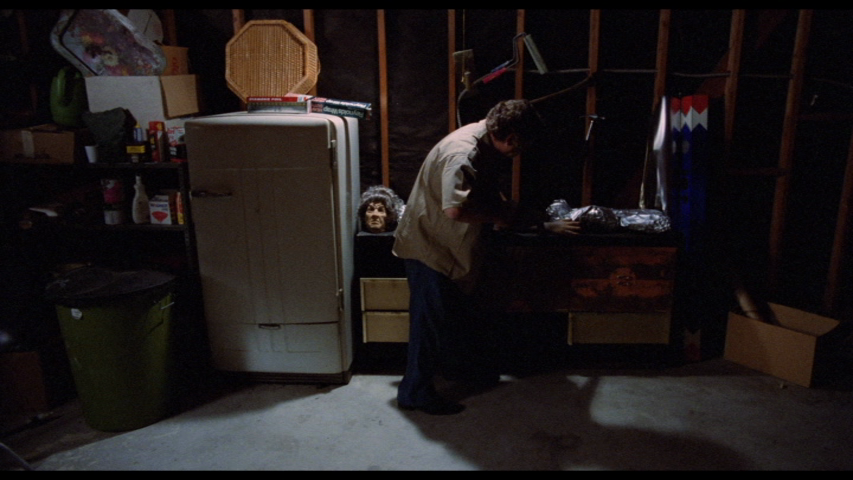
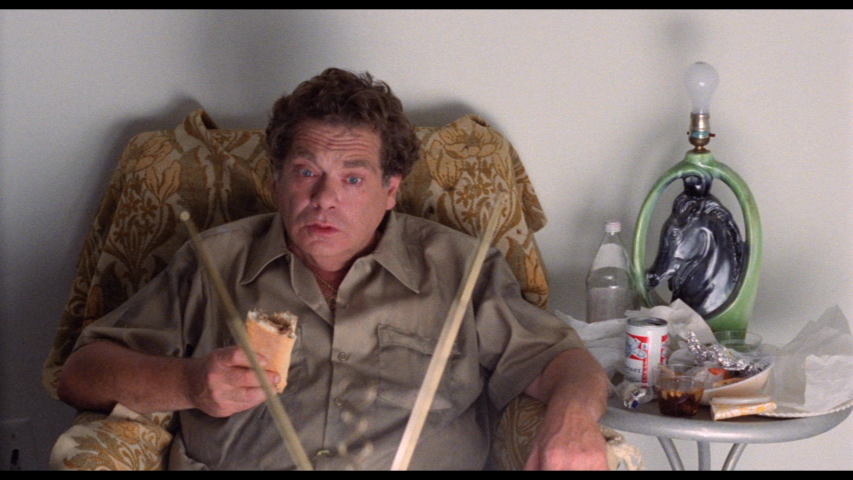

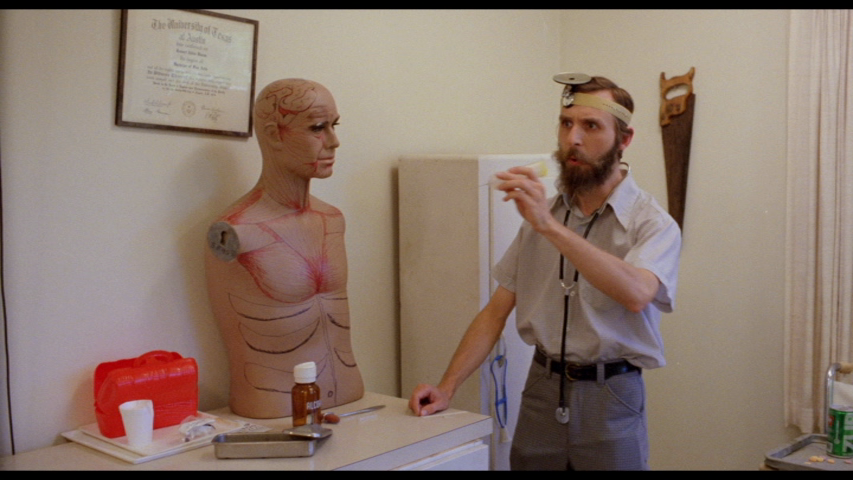
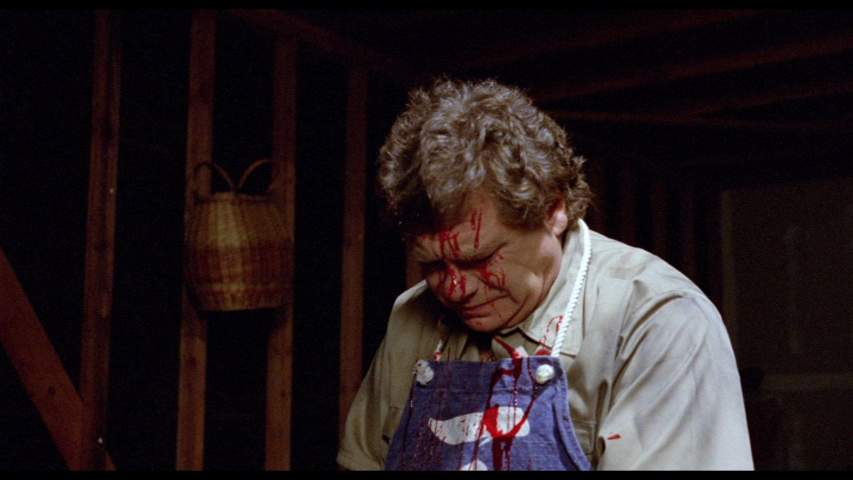

|


